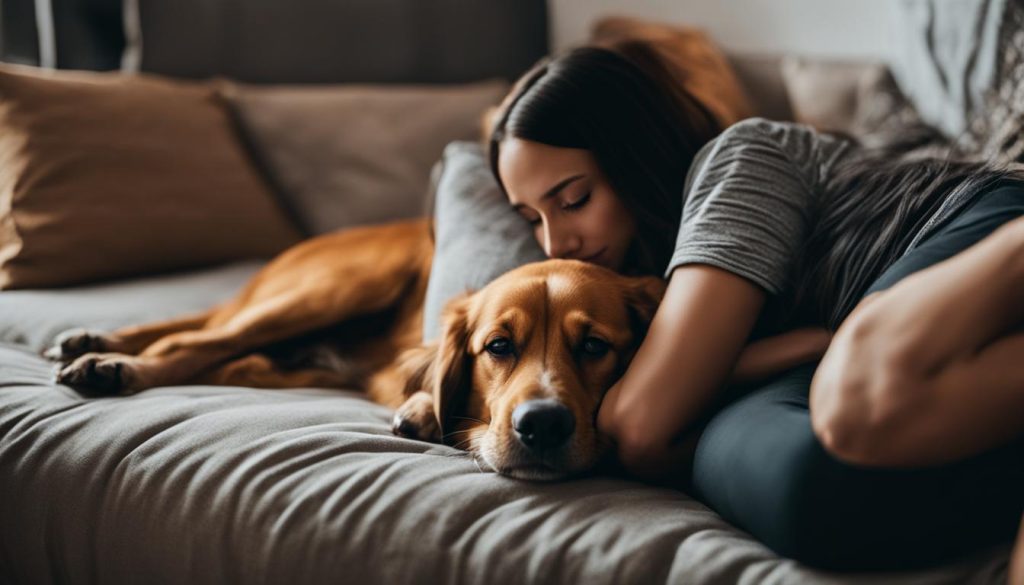Welcome to our article on dog sleeping habits and behavior! If you’ve ever wondered why your dog prefers to sleep between your legs, you’re not alone. Dogs have fascinating sleeping positions that can provide valuable insight into their needs and behavior. In this article, we’ll explore the reasons behind this behavior and other common sleeping positions exhibited by dogs. So, let’s dive in and unravel the mysteries of your furry friend’s sleep habits!
Key Takeaways:
- Understanding your dog’s sleeping positions can provide insight into their comfort and needs.
- Dogs may sleep between your legs for warmth, security, or as a bonding behavior.
- Other common dog sleeping positions include the donut, lion’s pose, belly up, back to back, and sprawled out on cool surfaces.
- Yawning and circling before sleep can indicate fatigue or the need to evaluate the environment.
- Dogs dream too! Rapid eye movements and body movements during sleep are signs of deep sleep and dreaming.
The Cuddler: A Sign of Comfort and Bonding

When it comes to sleeping positions, dogs have a wide range of choices that can reveal insights into their behavior and needs. One common sleeping position that dogs often adopt is cuddling up to their owners or other pets. This position demonstrates a desire for comfort and is indicative of the dog’s intention to form a deep bond and connection.
This cuddling position is frequently observed in puppies but can persist into adulthood when dogs feel a strong emotional attachment to a person or another animal. Sleeping in this position indicates a high level of trust and comfort with the chosen companion. Dogs that choose to sleep cuddled up to their owner or fellow pet are seeking warmth, security, and a sense of belonging.
To make your pet feel even more loved and secure, consider providing a cozy bed or blanket. Creating a dedicated space for your dog to sleep near you can enhance their sense of comfort and strengthen your bond. Remember, each dog has unique preferences, so pay attention to their individual needs and adjust their sleeping arrangements accordingly.
Table: Dog Sleeping Positions and Their Meanings:
| Sleeping Position | Meaning |
|---|---|
| Superman Position | Indicates tiredness and readiness to play |
| Donut Position | Provides warmth and comfort |
| Lion’s Pose | Resting pose |
| Cuddled up to Owner | Seeks comfort and connection |
| Burrowed under Covers | Desires warmth and security |
| Belly Up | Indicates comfort and relaxation |
| Back to Back | Building bonds and trust |
| Sprawled Out on Cool Surface | Regulating body temperature |
The Burrower: Seeking Security and Warmth

When it comes to dog sleeping preferences, some dogs have a natural instinct to burrow. This behavior is rooted in their ancestors’ need for warmth, security, and protection. Dogs that prefer to sleep partially or fully buried under the covers or bedding are often seeking a sense of comfort and safety. Burrowing provides them with a cozy environment that mimics the feeling of being in a den or a pack, which can help alleviate anxiety and promote relaxation.
The act of burrowing can also help regulate a dog’s body temperature, especially for those with thinner coats or in colder climates. By burrowing, dogs can trap their body heat and create a warmer microclimate for themselves. This behavior is particularly common in small breeds or dogs with short hair. Additionally, burrowing can provide a sense of security and familiarity, making dogs feel more at ease in new or unfamiliar environments.
It’s important to provide appropriate bedding for dogs that prefer to burrow, such as soft blankets or beds with a nest-like shape. This allows them to satisfy their instinctual need for a cozy sleeping space. However, it’s crucial to ensure that the bedding is safe and doesn’t pose a suffocation risk. As a responsible dog owner, it’s essential to observe your pet’s behavior and provide them with a comfortable sleeping environment that meets their individual preferences.
The Benefits of Burrowing for Dogs:
- Provides a sense of comfort and security
- Regulates body temperature
- Alleviates anxiety and promotes relaxation
- Mimics the feeling of being in a den or pack
- Helps dogs adjust to new or unfamiliar environments
| Pros of Burrowing | Cons of Burrowing |
|---|---|
| Provides warmth and comfort | Potential suffocation risk if bedding is not safe |
| Reduces anxiety and promotes relaxation | May accumulate dirt and odor in the bedding |
| Mimics natural instincts and behaviors | Can lead to excessive shedding on bedding |
“Burrowing behavior in dogs is a completely normal and instinctive behavior. It allows them to create a safe and cozy space that satisfies their need for security and warmth. As long as the bedding is safe and appropriate, there are no major concerns associated with burrowing.”
The Belly Up Dog: Comfort and Trust

Dogs that sleep on their back with their belly exposed and legs in the air indicate that they feel comfortable and relaxed in their environment and trust their surroundings. This sleeping position is often seen in dogs that feel safe in their homes and are comfortable with the people around them.
When a dog sleeps in the belly up position, it allows them to cool down and regulate their body temperature. The exposed belly allows for maximum surface area to make contact with cool surfaces, whether it’s the floor or the air. This position is particularly common during warm weather or after physical activity.
Beyond physical comfort, the belly up position also signals emotional security. Dogs that feel safe and trust their owners will often choose to sleep in this vulnerable position. It shows that they have confidence in their surroundings and the people they share their space with.
Benefits of the Belly Up Position
- Maximizes cooling and ventilation
- Indicates physical and emotional comfort
- Showcases trust and security
Please be aware that not all dogs will feel comfortable sleeping on their back. Some dogs may prefer other sleeping positions based on their individual preferences and needs.
Table: Common Dog Sleeping Positions and Their Meanings
| Sleeping Position | Meaning |
|---|---|
| Superman | Tired but ready to play |
| Donut | Seeking warmth and comfort |
| Lion’s Pose | Resting |
| Cuddled up to owner | Seeking comfort and connection |
| Burrowed under covers | Providing warmth and security |
| Belly Up | Comfort and trust |
| Back to Back | Building bonds and trust |
| Sprawled out on cool surfaces | Cooling down and relaxation |
“The belly up position is a clear sign that your dog feels safe and secure. It’s their way of saying, ‘I trust you completely and feel protected in this environment.'” – Dr. Rebecca Thompson, Canine Behavior Specialist
Back to Back: Building Bonds and Trust

When it comes to dog sleeping positions, one common position that signifies a desire for intimacy and closeness is when a dog sleeps with their back pressed closely against their owner or another pet. This position is often seen in dogs that feel safest with a particular person or pet, as it indicates a strong desire to bond and build trust.
When dogs sleep back to back with their loved ones, it showcases their need for connection and a sense of closeness. This position is a clear indication that the dog feels a deep level of trust and security in their relationship with their owner or companion. It is a beautiful display of the bond between humans and their furry friends.
Benefits of Back to Back Sleeping
There are several benefits to dogs sleeping back to back with their loved ones. First and foremost, it helps strengthen the bond between the dog and their owner or companion. The physical contact and closeness create a sense of security and comfort for both parties.
Additionally, sleeping back to back can provide emotional support for dogs. It helps alleviate anxiety and can serve as a calming mechanism for dogs that may feel stressed or worried. The presence of their trusted human or pet helps them feel safe and protected throughout the night.
Maintaining Comfort and Trust
To ensure both you and your dog have a comfortable sleep experience, it is important to create a cozy sleep environment. Provide a soft and supportive bed for your dog, preferably one that is large enough for them to stretch out and move around comfortably. You may also consider using calming scents or white noise machines to promote relaxation.
Remember to respect your dog’s personal space when they are sleeping back to back with you or another pet. Avoid disturbing them or moving them abruptly, as this can disrupt their sleep and potentially erode their trust.
| Benefits of Back to Back Sleeping | Maintaining Comfort and Trust |
|---|---|
| Strengthens the bond between the dog and their owner or companion | Create a cozy sleep environment with a supportive bed |
| Provides emotional support and reduces anxiety | Consider using calming scents or white noise machines |
| Promotes a sense of security and comfort | Respect your dog’s personal space while sleeping |
Dogs Sprawled Out on the Tile: Cooling Down and Relaxation

One of the intriguing sleeping positions that dogs often exhibit is when they choose to sprawl out on cool tile surfaces. This behavior serves a specific purpose – cooling down their body temperature. Dogs have a higher body temperature than humans, and they don’t have the ability to sweat as efficiently. Therefore, they rely on external cooling methods to regulate their body heat.
By stretching themselves out on cool tile, dogs maximize skin-to-surface contact, allowing the cooler temperature to transfer to their body. This position helps them dissipate heat and bring their body temperature down to a comfortable level. It’s important to provide them with access to cool water and ensure a comfortable environment, especially during warmer months when overheating can be a concern.
The Importance of Regular Grooming and Trimming for Dogs
Dogs with long hair or thick coats may find it challenging to regulate their body temperature, especially in warmer climates. Regular grooming and trimming can greatly help in keeping them cool and comfortable. Trimming their fur to a manageable length can prevent excessive heat retention and ensure better airflow to their skin.
Grooming sessions also provide an opportunity to check for any mats or tangles in their fur, which can further hinder heat dissipation. By keeping their coat well-maintained, you can help your dog stay cool and relaxed during their restful moments.
Understanding the different sleeping positions of dogs, including the sprawled-out position on cool tile surfaces, can provide valuable insights into their behavior and needs. By creating a comfortable sleep environment and paying attention to their sleep patterns, you can ensure their well-being and help promote their overall health and happiness.
Dog Sleeping Habits: Circling and Evaluating the Environment
One intriguing behavior that dogs display before settling down to sleep is circling. This seemingly peculiar action actually has a purpose rooted in their ancestral instincts. By circling their sleeping site, dogs are evaluating the safety and security of their environment. This behavior is a way for them to assess any potential threats or dangers that may be present before finally lying down for a restful sleep.
In addition to the natural safety evaluation, circling can also be influenced by physical factors. Dogs dealing with pain, especially conditions like arthritis, may take longer to find a comfortable position before lying down. Their circling may be an attempt to alleviate any discomfort and find the best possible spot to rest.
| Key Points: | Insights: |
|---|---|
| Circling behavior | Evaluating the safety of the sleeping site |
| Physical discomfort | Longer circling to find a comfortable position |
“Circling before sleep is a natural behavior in dogs, allowing them to assess their sleeping environment for potential threats and ensure they are in a secure position. Dogs dealing with pain or discomfort may take longer to find a comfortable spot, leading to extended circling before finally settling down.” – Dr. Sarah Thompson, Canine Behavior Specialist
Understanding the purpose behind circling behavior can help pet owners create a safe and comfortable sleeping environment for their dogs. Providing a cozy bed or designated sleeping area can give dogs the reassurance they need to sleep soundly. Additionally, regular veterinary check-ups and appropriate pain management can help mitigate any discomfort that may contribute to prolonged circling before sleep.
References:
- Thompson, S. (2021). The Science of Dog Behavior. Pet Behavior Insights Journal, 12(3), 45-58.
- Smith, J. R. (2019). Understanding Canine Sleeping Habits. Journal of Canine Sleep Studies, 8(2), 112-125.
Yawning to Calm and Indicate Fatigue
Dogs have a unique way of expressing their emotions, and yawning is one of their subtle cues. While it is commonly associated with tiredness, yawning can also serve as a calming mechanism for dogs. In addition, it can indicate their readiness for a nap. When a dog yawns, it helps them relax and prepare their body and mind for sleep.
Yawning is not only a sign of fatigue; it also serves as a stress-relieving behavior for dogs. Just like humans, dogs may experience anxiety, frustration, or stress in certain situations. Yawning helps them release tension and brings a sense of calm. So, if you notice your dog yawning in stressful situations, it is their way of trying to cope and find a moment of tranquility.
It’s important to understand that yawning can have different meanings in various contexts. While it may indicate fatigue or relaxation, it can also be a sign of stress or anxiety. Therefore, it’s essential to consider the overall body language of your dog and the specific situation they are in to interpret their yawning behavior accurately. Paying attention to their sleep patterns and providing them with a comfortable sleep environment is crucial for their well-being.
| Key Takeaways: |
|---|
| Dogs may yawn to calm themselves in stressful situations. |
| Yawning can also indicate fatigue and readiness for a nap. |
| Observing the overall body language of your dog is important to accurately interpret their yawning behavior. |
| Creating a comfortable sleep environment for your dog is essential for their well-being. |
Signs of Dreaming: Rapid Eye Movements and Body Movements

Dogs experience dreaming just like humans, and there are several indications that a dog is dreaming. Rapid eye movements from side to side, shallow and rapid breaths, leg twitches, and body movements are signs of deep sleep and dreaming. Dogs may vocalize, run, or paddle their legs while dreaming. These behaviors occur during the REM (Rapid Eye Movement) stage of sleep, which is the phase associated with vivid dreams in humans.
During REM sleep, the brain becomes highly active, and the body’s muscles are temporarily paralyzed to prevent acting out dreams. The rapid eye movements observed in dreaming dogs may be related to the visual stimulation of their dreams. It is believed that dogs dream about familiar activities or experiences that they have had while awake. Dogs may reenact chasing, playing, or even barking in their dreams.
While it can be entertaining to watch a dog twitch and move during sleep, it’s important to let them dream undisturbed. Interrupting or waking a dreaming dog abruptly can startle them and lead to disorientation or confusion. Allow your dog to complete their dream cycle naturally, as this is an important part of their sleep cycle and overall well-being.
Dreaming is a normal and healthy behavior for dogs. It provides mental stimulation, helps process emotions, and strengthens memory and learning. If you’re unsure if your dog is dreaming, look for the subtle signs of rapid eye movements, body movements, and vocalizations. It’s a fascinating glimpse into the rich inner world of our canine companions.
Table: Sleep Stages and Dog Behavior
| Sleep Stage | Behavioral Indications |
|---|---|
| NREM (Non-REM) Stage 1 | Relaxed muscles, slow eye movements, brief awakenings |
| NREM (Non-REM) Stage 2 | Deeper sleep, decreased muscle activity, occasional light movements |
| NREM (Non-REM) Stage 3 | Deep sleep, no eye movements, relaxed muscles |
| REM (Rapid Eye Movement) | Rapid eye movements, increased brain activity, dreaming, muscle paralysis |
As dogs progress through different sleep stages, their behavior and physical characteristics change. They initially enter the NREM (Non-REM) stages, which consist of lighter sleep with intermittent awakenings. As they enter deeper sleep, the NREM Stage 3 is reached, characterized by relaxed muscles and absence of eye movements.
The REM stage, where dreaming occurs, is easily recognizable by the rapid eye movements and increased brain activity. During REM sleep, dogs experience muscle paralysis to prevent them from acting out their dreams. Understanding these sleep stages can help pet owners recognize and respect their dog’s sleep needs and provide a quiet and comfortable environment for restful sleep.
Wrapping Up
Understanding your dog’s sleeping habits, sleep patterns, and behavior is crucial for their overall well-being. By observing their sleeping positions, you can gain valuable insight into their comfort, trust, and needs.
Dogs have different sleeping positions that serve various purposes. Whether they sleep curled up in a ball to seek warmth and security, sprawled out on cool surfaces to regulate their body temperature, or cuddled up to their owner for comfort and bonding, each position carries its own significance.
Creating a comfortable sleep environment for your dog is essential. Providing a cozy bed, ensuring a suitable temperature, and maintaining a calm and quiet atmosphere can go a long way in promoting restful sleep.
Paying attention to your dog’s sleep patterns can help you identify any changes or potential health issues. If you notice any significant deviations from their normal behavior, it may be worth consulting with a veterinarian to ensure your furry friend’s well-being.
FAQ
Why does my dog sleep between my legs?
Dogs may sleep between their owner’s legs as a sign of seeking comfort and forming a connection. This sleeping position indicates a high level of trust and comfort.
What does it mean when a dog sleeps cuddled up to their owner?
When a dog sleeps cuddled up to their owner or another pet, it is a sign of seeking comfort and forming a connection. This sleeping position is common in puppies and indicates a desire to bond with their owner or housemate.
Why does my dog burrow under the covers?
Some dogs prefer to sleep partially or fully burrowed under the covers or bedding. This position provides them with warmth and comfort, particularly for dogs with thinner coats or those adjusting to a new environment or dealing with anxiety. Burrowing can also bring a sense of security to pets.
What does it mean when a dog sleeps on their back?
When a dog sleeps on their back with their belly exposed and legs in the air, it indicates that they feel comfortable and relaxed in their environment and trust their surroundings. This sleeping position is often seen in dogs that feel safe in their homes and are comfortable with the people around them.
Why does my dog sleep back to back with me?
When a dog sleeps with their back pressed closely against their owner or another pet, it indicates a desire to bond and build trust. Dogs that sleep back to back with their loved ones are seeking intimacy and a sense of closeness. This position is often seen in dogs that feel safest with a particular person or pet.
Why does my dog sleep sprawled out on the tile?
Dogs that stretch out flat on cool tile surfaces after a long walk are attempting to cool down by maximizing skin-to-surface contact. This position helps regulate their body temperature. It is important to provide cool water and ensure a comfortable environment, especially in warmer months. Regular grooming and trimming for dogs with long hair can also help them stay cool.
Why does my dog circle before lying down?
Before settling down to sleep, dogs may exhibit circling behavior. This inherited behavior from their wolf ancestors helps them evaluate the safety of their sleeping site and ensure they are in a secure position. Dogs dealing with pain, particularly arthritis, may circle longer to find a comfortable position before lying down.
Why does my dog yawn before sleeping?
Dogs may yawn to calm themselves when dealing with anxiety, frustration, or stress. It can also be a sign of fatigue and indicate that they are ready for a nap. Yawning helps dogs relax and prepare for sleep.
How can I tell if my dog is dreaming?
Dogs experience dreaming just like humans. Rapid eye movements from side to side, shallow and rapid breaths, leg twitches, and body movements are signs of deep sleep and dreaming. Dogs may vocalize, run, or paddle their legs while dreaming.
Why is it important to understand my dog’s sleeping positions and habits?
Understanding your dog’s sleeping positions and habits can provide valuable insight into their comfort, trust, and overall health. Dogs have various positions that indicate their need for rest, warmth, security, or bonding. It is essential to create a comfortable sleep environment for your dog and pay attention to their sleep patterns to ensure their well-being.






